
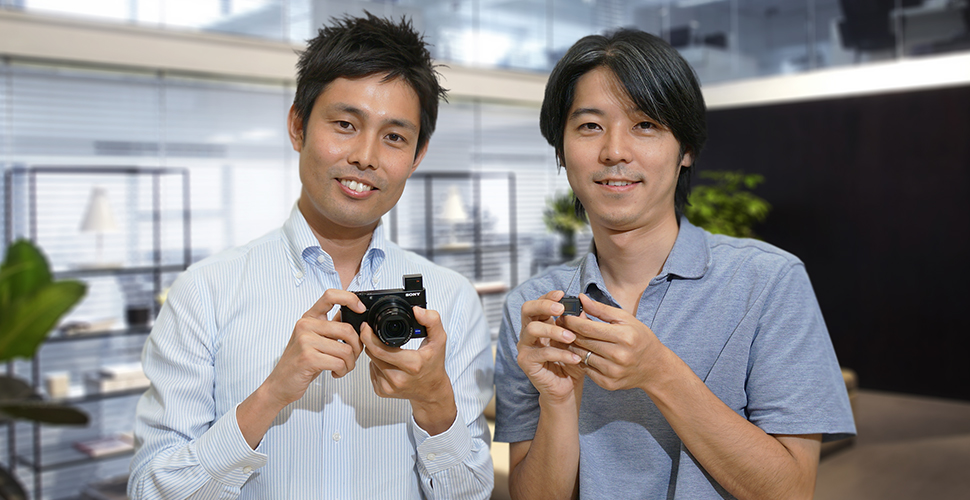
The RX100 IV packs super slow motion, 4K video, and other technologies developed for professional-level video cameras into a compact body.
Two Cyber-shot® cameras that enable general consumers to enjoy professional imaging experiences, RX100 IV and RX10 II, were launched this summer. Packing the technologies developed for professional-level video cameras into a compact body, these next-generation cameras deliver stunning imaging experiences with functions such as super slow motion video capture and 4K video shooting. In the U.S., where the cameras were released ahead of other countries and regions, the RX100 IV has maintained its top position in the premium compact camera market by value since its debut.
This report contains an interview with two engineers involved in the development of the RX100 IV, which is also popular among interchangeable lens camera (ILC) users who use it as a sub camera. We asked them about what they intended to accomplish with the RX100 IV and what they had to go through before this product was born.
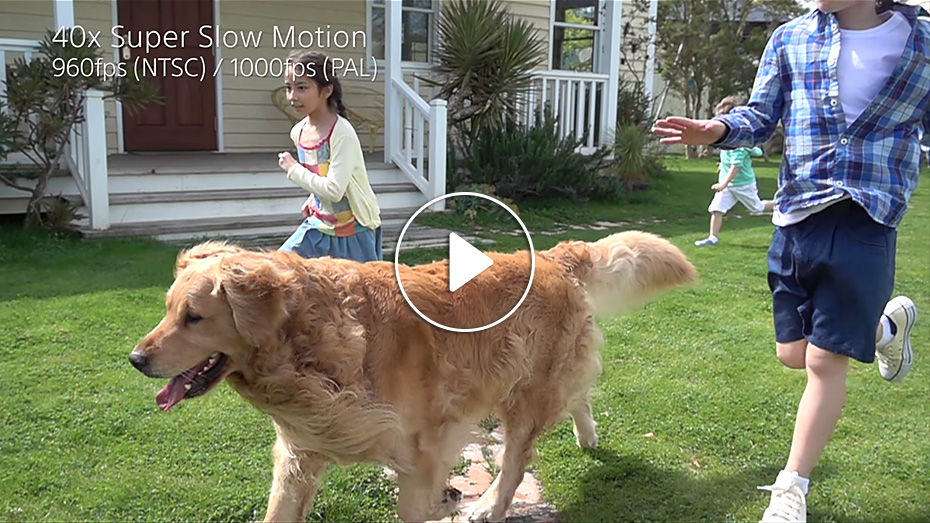

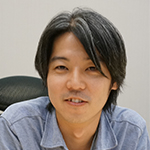
Developed to take still image cameras to a higher level of perfection while keeping their design and size intact, the RX100 IV attracts new users with video as well.

The RX100 IV is the fourth model of the RX100 series. Our strategy for this series is that we give each model unique features and sell these distinct models together. What we put emphasis on is the universal design and size. The concept of providing high-quality image in a compact, palm-size body has always remained unchanged.
Since the RX100 - the first RX100 series model - was launched in 2012, we have repeatedly discussed how to step up this line continuously to take it to a higher level of perfection. The RX100 IV has been developed as the next-generation premium compact camera. It is intended not only to advance the evolution of still image cameras but also to attract new users with its enhanced video quality and advanced features. When we started the development of the RX100 IV, we thought that an increasing number of users would record video with DSLR cameras, and that we should develop a new type of camera that professional photographers and videographers would use as a sub camera for video shooting.
To meet this goal, we have given the RX100 IV up to 40x super slow motion shooting*1 that captures momentary movements invisible to human eyes. Utilizing the high-speed processing capability of the world's first 1.0 type stacked Exmor RS™ CMOS sensor*2, we have realized a number of outstanding functions, such as an ultra-fast Anti-Distortion Shutter with a maximum speed of 1/32000 second that allows clear images to be captured with a wide open aperture at high brightness levels, as well as 4K video shooting*3 and dual video recording, both of which have been implemented for the first time in the Cyber-shot series.
While the initial model was very well received, we had some customers who would like to make better use of the large aperture of f/1.8 for shooting in bright lighting conditions such as a sunny outdoor environment. To meet this request, we released the RX100 III in 2014 that featured a newly-developed lens with a built-in ND filter. This made it possible to set the aperture to 3 different levels and to adjust the light intensity down to 1/8, accommodating the needs of those users who wanted to shoot with slow shutter speeds or with an open aperture in bright lighting conditions such as an outdoor environment. But, we were still unable to meet all the outdoor shooting needs at the time, and that made us keen to resolve this issue with the RX100 IV using new technologies.
*1: Sound cannot be recorded when shooting slow motion. An SDXC memory card of Class 10 or higher is required
*2: The world's first as 1.0-type sensor with memory-attached design, as of announcement date Jun. 2015, Sony survey
*3: An SDXC memory card with a Class 10 or higher speed rating is required for XAVC S recording and UHS Speed Class 3 is required for recording at 100Mbps. Clip 4K - super-real 4K movie feature for casual 4K shooting of up to 5 minutes.
New sensor and electronic shutter developed through close in-house collaboration.

Two things caught our attention. One is the image sensor, and the other is the electronic shutter. With the RX100 IV, the Anti-Distortion Shutter using the newly developed stacked 1.0 type CMOS sensor with a DRAM memory chip allows images to be captured with a wide open aperture. Now it is no exaggeration to say that there are no scenes that you cannot capture with an aperture of f/1.8.
If we used a mechanical shutter to meet our target, the body of the camera would become large. So we ruled out this idea from the beginning. The conventional electronic shutter was poor at capturing fast moving subjects and had the shortcoming of distorting motion, and we had no intention of compromising on that, either. How could we make it possible to read and process about 20.1 effective megapixels of data instantaneously? We thought that the newly developed stacked sensor technology might do the trick, and that was when a full-fledged joint study by the camera and image sensor development teams got underway.
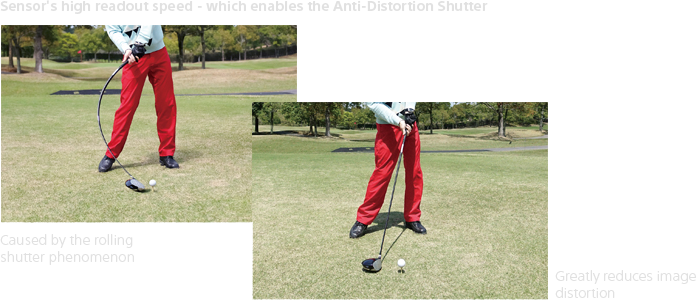

Our study began by exploring ways to introduce an Anti-Distortion Shutter system compatible with an electronic shutter that supports high-speed shooting with little image distortion. We also had another problem to solve. At that time, the read data could not be received by the system, which made it impossible for the image sensor to output the data. We then proposed to mount a DRAM chip on the image sensor to store the data in the memory temporarily. This proposed method turned out to be very difficult to implement since we had barely begun the development of the image sensor and it was hard to mount a DRAM chip on the 1.0 type sensor, which was the largest stacked sensor.

In order to implement the proposed method, the camera and image sensor development teams had to have a clear distinction between their respective roles and work in close collaboration. Since the development was done in-house, the members of both teams were able to talk to one another anytime and work together to overcome challenges. Otherwise, it would have been impossible to get it done. So this is a huge advantage for us.
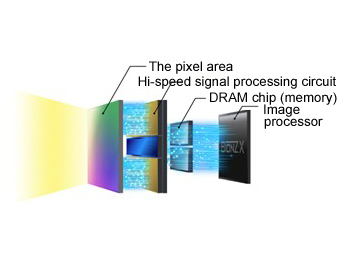

As a result, we now have an image sensor that can process an unprecedented amount of data at a high speed. It achieves a data readout speed more than 5x faster*4 than the conventional back-illuminated CMOS sensor.

I am proud that we have been able to develop a next-generation electronic shutter that is one step ahead of competitors' products. The biggest appeal of the RX100 IV is that you can shoot without worrying about anything even in camera unfriendly conditions where the subject is backlit by the sun or on sun-splashed beaches and snowy mountains. I look forward to seeing utterly new forms of shooting expression born with this camera.

Our goal was to develop a camera that would allow the user to take photos anywhere in the world. The RX100 IV features an Anti-Distortion Shutter with a maximum speed of 1/32000 second, and enables clear images to be captured with a wide open aperture at brightness levels up to EV19*5, a condition in which taking photos was previously impossible. It also minimizes the "rolling shutter" effect commonly experienced with fast moving subjects. A field test we did recently shows that the camera is capable of capturing sharp images of a golf swing. Also, the new electronic shutter has increased the continuous shooting speed to 16fps, up from 10 fps on the RX100 III. Although continuous shooting is limited to auto focus mode, the camera allows you to capture a series of still images continuously almost as if you are recording video. And you never lose sight of the subject.
*4: Compared to previous RX100 III and RX10 models. According to a simulation of the same electronic shutter of up to 1/32000 sec. combined with the Exmor R CMOS sensor employed with RX10 or RX100 III
*5: Using a built-in ND filter
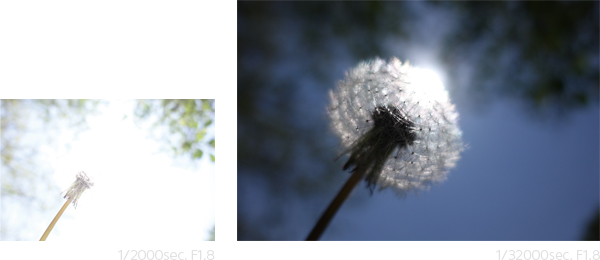
Super slow motion capture and 4K video shooting functions provide outstanding image quality that stuns even its developers.

Our strength in creating cameras that overwhelm competitors comes from the fact that not only the core devices - lenses, image sensors, and processors - but also the software and algorithms necessary to bring the best out of those devices, are all developed in-house. Particularly, to enable super slow motion shooting in high frame rate (HFR) mode, we needed to implement new software.

For super slow motion shooting, the available frame rates are 960, 480, and 240 fps, and the available playback formats are 60p, 30p, and 24p in NTSC. For example, you can record and play back a mere two seconds of video (960 fps) as 80-second-long (40x) slow motion video (24p). At 240 fps, the recorded footage looks dramatic as the image quality can be as high as full HD, and at 960 fps, even minute movements can be seen. Capture video of insects or birds, and you'll be amazed to see a world that has never unfolded before. If you shoot video of the street from inside a car at 960 fps, you'll find it interesting that people walking seem to be motionless. In a heavy downpour, rain looks like lines to human eyes. But, in slow motion video, you can see individual drops of rain.
When we equipped the professional-use NXCAM camcorder NEX-FS700 with full HD and up to 10x (240 fps) slow motion shooting capabilities, we were praised for implementing such capabilities in a compact camera. The RX100 IV is the only camera that is even more compact and capable of capturing super slow motion video without compromise of image quality. It is small and easy to use in everyday life. Since it supports many different ways of shooting, it can be used as a sub camera for professional photographers as well.


We have repeated field tests, each of us carrying an RX100 IV camera. When we saw the high image quality of a super slow motion video showing us playing baseball, we were stunned. Movements invisible to human eyes can be recorded with amazingly high image quality. Just capturing moments of movement in slow motion adds to the artistic quality of the footage. Scenes of everyday life, such as people riding scooters or kids playing around, look so dramatic when they are recorded in slow motion. It's really fun.
With the RX100 IV, you can capture two to four seconds of slow motion video. That may sound quite short, but the camera is designed taking into account how you use the slow motion shooting capability. For example, you never know when a decisive moment comes, but you cannot keep recording endlessly. So, in addition to the 'start trigger' that causes the camera to record for a certain period of time after you press the MOVIE button, we have provided an 'end trigger' that instructs the camera to go backwards a certain period of time and create slow motion video when you realize a decisive moment and press the button. This feature is based on the knowledge we have gained from professional-use cameras and is very well received for its ease of use. Professional users have also praised the feature, saying: "We've been able to capture decisive moments thanks to the 'end trigger'." This is the very fruit of the collaboration between software and hardware.
4K video shooting is one of the major features, and it means a lot that we have achieved this feature for a camera of this size. The RX100 IV supports high-resolution, wide-range 4K video shooting, high quality image recording at 100 Mbps, full pixel readout without pixel binning, and professional-level capabilities like XAVC S and Picture Profile. I think this makes the RX100 IV perfect as a sub video camera that can be taken anywhere.

I use the 4K video shooting and super slow motion capture functions very frequently because my kids love them.
Dual video recording is awesome, too. Thanks to the stacked CMOS sensor built in this model, still images captured with the dual video recording*6 function can be read at a high resolution of about 17 megapixels without pixel binning, resulting in a phenomenal improvement in image quality.
*6: allowing shooters to capture 16.8 MP still images during 4K video recording in any of 11 different composition patterns simply by pressing the shutter button
Do you have a message?

We had discussions in the development team about what features we would like to implement and how we would implement them in a camera of this particular design and size. We also got advice from the professional-use camera design team. All these efforts have enabled us to pack video capabilities that impress even professionals into this compact camera, which has come close to the level of excellence of professional-use cameras.
Since the camera was put on the market, we have received very positive feedback from users, which is what keeps us motivated throughout the development process. Users say: "With this camera, I can take photos anywhere. I always carry it in my bag." And that's what I wanted to hear. Based on the requests from users, we have made a lot of small improvements, such as making it possible to set the lower limit on the shutter speed in ISO AUTO mode. Some of these improvements are not mentioned in the manual, but there are photographers and general consumers who recognize the improvements and thank us for them. That makes me really happy.
I have come to realize that good products stand the test of time. There are many users who are still using the initial model even today. When a new product comes unchanged in form, they will know what Sony values. Choose from a lineup of products from the initial model to the latest one as it suits your purpose, and you'll definitely come to find the RX indispensable to you (laughter). This product reflects the passion of members of the image sensor team, staff of the manufacturing sites, people in planning and marketing, and many other individuals. I hope that all of us at Sony will come together and make sure that every RX model stays on the market for a long period of time.

The members of the RX development team have a strong sense of solidarity and are highly motivated to create amazing products, so I was able to do the development work in a good atmosphere. When we displayed images with the new sensor for the first time or when we did the demo of slow motion or whenever something new came up, the whole team became excited and more united. And this team has developed a camera that is compact, yet just as sophisticated in performance as professional-use cameras. I hope that everyone enjoys new shooting experiences with slow motion capture, 4K video shooting, and the ability to capture sharp, still images without blur.